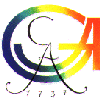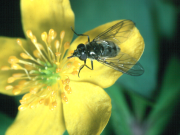Institute of Zoology and Anthropology
Klaus Hövemeyer

|
Ecology Research Group
Institute of Zoology and Anthropology Klaus Hövemeyer |

|
|
Research Interests
The Allium ursinum food web

Insect-plant relationships form another important item on my research agenda. 
I am interested in the strategies employed by all Allium-feeders but my research has largely concentrated on the hoverfly Cheilosia fasciata, which is by far the most abundant herbivore species (For an illustrated life cycle of C. fasciata click here).
I have studied many aspects of the ecology of Cheilosia fasciata. For example, correlation analyses, key factor analysis, and experimental studies showed that the population dynamics of this species are almost equally strongly influenced by
(ii) competition for food among older larvae, (iii) parasitization of pupae. Further studies considered diurnal activity patterns of adult Cheilosia fasciata, oviposition behaviour of females (Hövemeyer 1995, 1996), nutrient and energy flow in the plant-herbivore-parasitoid food chain (Hövemeyer 1995). For example, females lay only one egg per leaf (first observed by Nielsen 1979), and this habit can serve to reduce competition among larvae (Hövemeyer 1987). Selected Publications KRATOCHWIL, A. & SCHWABE, A. (2001): Ökologie der Lebensgemeinschaften. Eugen Ulmer, Stuttgart. NIELSEN, T.R. (1979): Hoverflies (Diptera, Syrphidae) associated with ramson Allium ursinum L. Fauna Norvegica, Series B 26: 21-23. HÖVEMEYER, K. (1996): Egg laying in the leaf-mining hoverfly Cheilosia fasciata (Diptera: Syrphidae): Do females select large leaves for oviposition, and does it matter? Zoologische Beiträge 37: 171-184. HÖVEMEYER, K. (1995): Seasonal and diurnal activity patterns in the hoverfly Cheilosia fasciata (Diptera: Syrphidae). Entomologia Generalis 20: 87-102. HÖVEMEYER, K. (1995): Trophic links, nutrient fluxes, and natural history in the Allium ursinum food web with particular reference to life history traits of two hoverfly herbivores (Diptera: Syrphidae). Oecologia 102: 86-94. HÖVEMEYER, K. (1992): Population dynamics of Cheilosia fasciata (Diptera: Syrphidae), a leaf miner of ramson, Allium ursinum. Ecological Entomology 17: 331-337. HÖVEMEYER, K. (1987): The population dynamics of Cheilosia fasciata (Diptera, Syrphidae): significance of environmental factors and behavioural adaptations in a phytophagous insect. Oecologia 73: 537-542. |
|